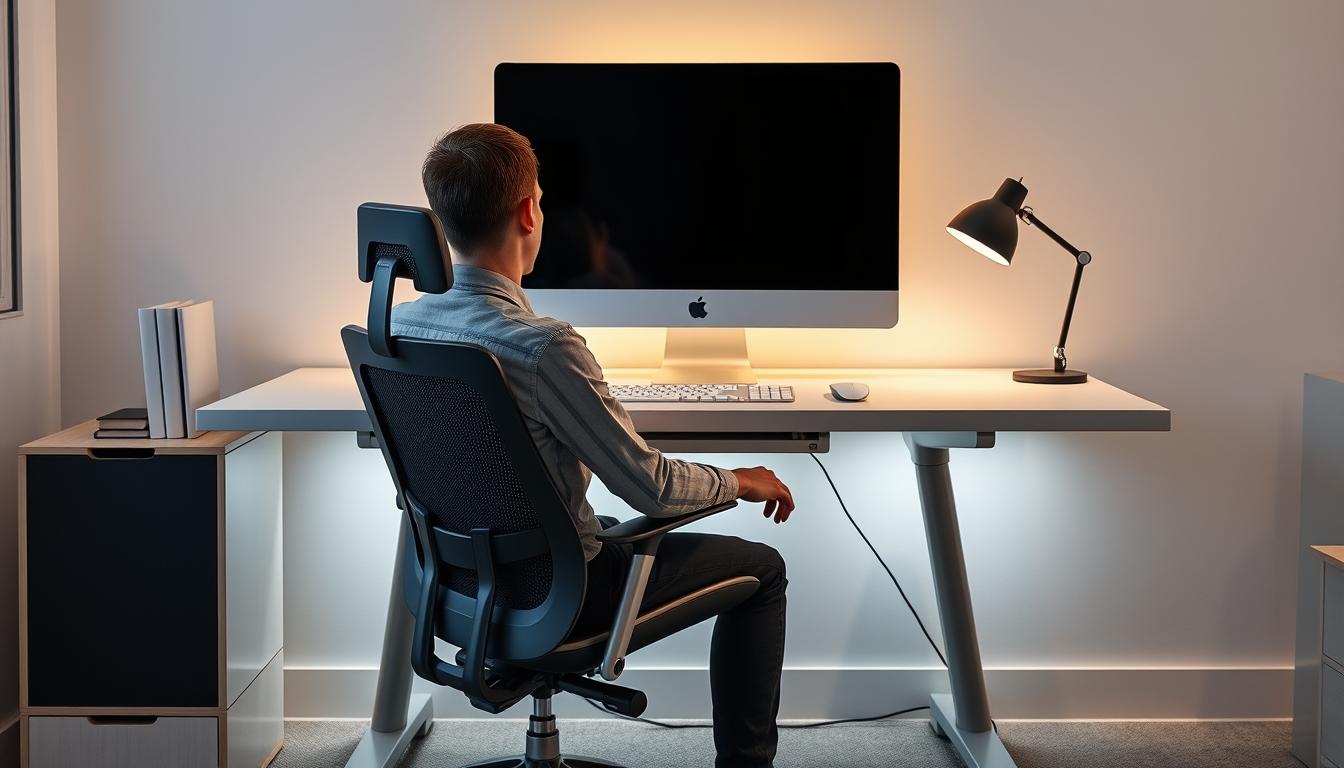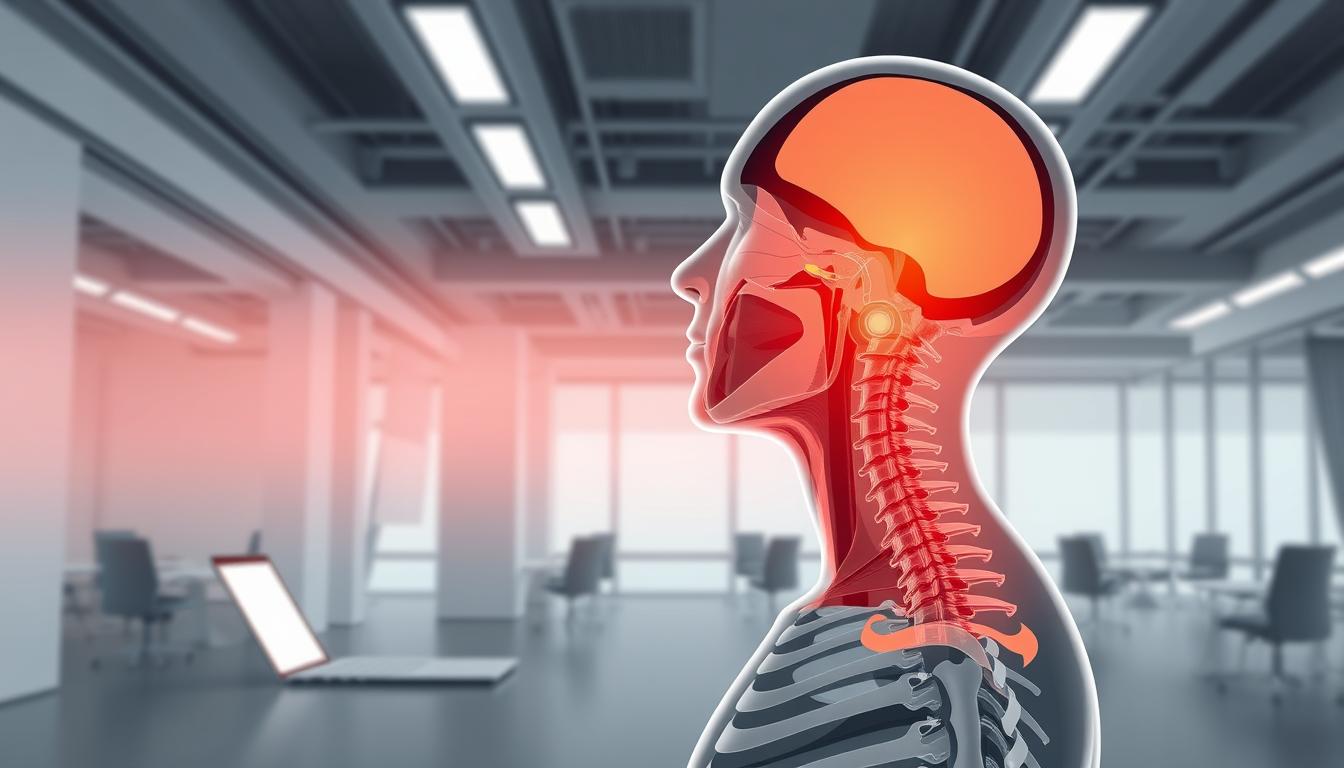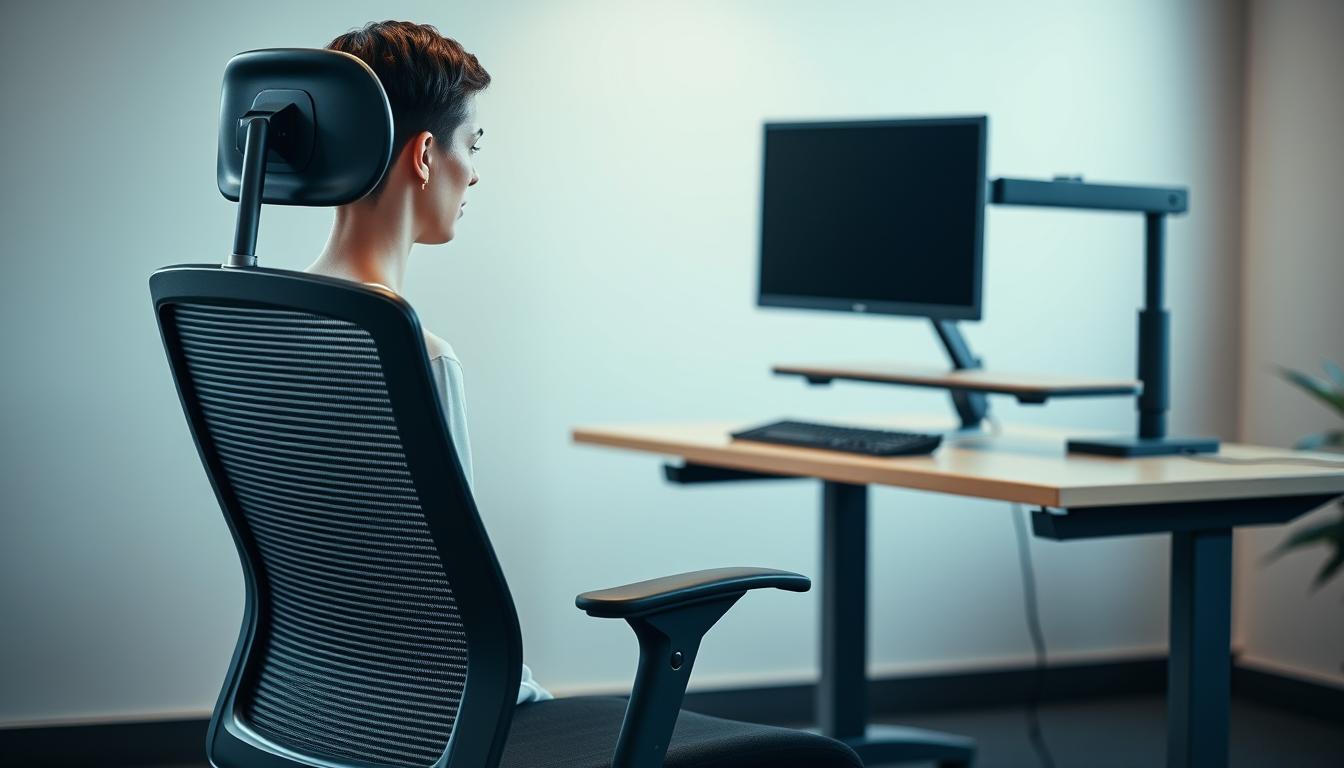In the digital age, choosing between a laptop stand and a monitor matters a lot. It can really change how comfy your neck is and how productive you are at work. Knowing how to set up your workspace the right way is key.
This guide will look at why laptop stands might be better than regular monitors. We aim to give you helpful tips to pick what’s best for your neck’s health.
Understanding Ergonomics in the Workplace
Creating a healthy workspace means knowing how to set it up ergonomically. It’s key to keep our posture right while we work. With an ergonomic setup, we can avoid discomfort and protect our health, cutting down on the risk of major health problems.
Importance of Proper Posture
Standing or sitting the right way is crucial to avoid injury from sitting too long. Using chairs and desks that help us sit straight can ease muscle and joint stress. When we’re comfortable, we can do our work better, without getting distracted by pain.
Health Risks of Poor Ergonomics
Ignoring ergonomics at work can cause health issues. Workers might start feeling discomfort, which can turn into constant pain in the neck, back, and shoulders, along with injuries from doing the same motions over and over. Over time, bad posture can even lead to heart disease and weight gain.
Laptop Use and Neck Discomfort
Laptop use often leads to serious neck pain. Their small design makes people sit in bad positions. This results in common neck problems due to the low screen height.
Looking down for too long causes issues like chronic pain and muscle disorders.
Common Neck Issues Related to Laptop Use
Many laptop users suffer from neck problems. Symptoms include:
- Neck stiffness
- Pain radiating to shoulders
- Increased tension headaches
- Potential development of kyphosis
These problems usually come from sitting poorly because people lean into their screens. This can strain neck muscles a lot.
Impact of Low Screen Height on Posture
Low screen height is bad for your posture. When the laptop is too low, people bend forward to see better. This wrong position puts a lot of pressure on the neck and shoulders.
Staying this way for too long can cause lasting pain. It also makes it hard to move comfortably.
The Role of Laptop Stands
Laptop stands are key in making users more comfortable and productive. They lift the laptop to eye level. This helps improve posture and reduces neck and shoulder strain. Such posture benefits are huge as they lower health risks linked with long laptop use.
Finding out about the various stands can lead to picking the best one.
How Laptop Stands Improve Ergonomics
Laptop stands are greatly ergonomic. They keep the spine in a straight position, easing neck and back pain. Thanks to their ability to adjust height, users can tailor their work setup. This adjustment lessens spine pressure, boosts posture, and increases work efficiency.
Different Types of Laptop Stands and Their Benefits
There are many kinds of stands, each serving different needs:
- Fixed Riser Stands: Perfect for those with a specific work area, as they have a constant height.
- Adjustable Stands: These stands offer height adjustments, ideal for different users or tasks.
- Portable Stands: Made for people on the move, they combine convenience with ergonomic features.
Some stands also have cooling features to stop laptops from overheating. This ensures they work well for longer periods. Choosing the correct stand is crucial for the best ergonomic advantage.
Monitor Setup for Better Comfort
To create a comfy monitor setup, you need to get the height and distance right. This is key to keeping your neck healthy and avoiding pain when you’re working.
Adjusting Monitor Height for Neck Health
Where your monitor sits can really affect your neck. You want the top of the screen to be level with your eyes or a bit lower. This way, you don’t have to bend your neck down and get sore. Fine-tuning your monitor’s height now and then helps keep your posture good all day.
The Ideal Distance and Angle from the Monitor
How far you sit from your monitor matters too. Your screen should be about as far as your arm can reach. This keeps your eyes comfy and your view clear. Aim for a distance of 20 to 40 inches to take care of your neck and see well. Adjusting the angle right makes things even better, cutting down on discomfort and boosting your work vibe.
Laptop Stand vs. Monitor: Which Is Better for Your Neck?
Choosing between a laptop stand and a monitor can really affect how your neck feels. When we compare them, we see that both have pros and cons depending on how you work and what’s comfortable for you.
Comparative Analysis of Stress on Neck
How the screen is set up is key to less neck pain. Laptop stands raise the screen to keep your gaze up, which prevents you from bending your neck too much. But using a laptop without a stand often makes you bend your neck, causing pain after a while.
Monitors are great because you can change their height and how far they are from you. This means you can set them up just right for long work sessions, making them a good choice for avoiding neck pain.
When to Use a Laptop Stand
If you’re always on the move, a laptop stand is a smart pick. It’s perfect for making any spot, like a coffee shop or airport, into a comfortable workspace. Your neck will thank you because the screen will be at eye level, so you don’t have to slouch.
When to Choose a Monitor Setup
For those who work long hours at a desk, a monitor is the way to go. You can adjust a monitor in many ways to make sure it’s just right for you. Monitors are better at keeping your neck happy during those long days at your desk, compared to a laptop stand.
Enhancing Your Home Office Environment
Setting up an efficient home office needs careful planning, focusing on your desk and comfort. Choosing wisely can make working from home much more comfortable. Think about how your desk is arranged and what items might make you feel better while working.
Considerations for Your Desk Space
Your desk space must help you work smoothly. It’s important to place your desk so you can sit upright and reach everything easily. Keep in mind these points:
- Desk height should allow your elbows to remain at a 90-degree angle.
- Monitors should be at eye level, reducing neck strain.
- Keep essential items within reach to avoid unnecessary stretching.
Essential Accessories for Improved Comfort
Adding certain comfort accessories can make a big difference in how you feel in your home office. Think about getting these items:
- Ergonomic chairs: Provide lumbar support to maintain spine alignment.
- Wrist rests: Help alleviate wrist strain during typing tasks.
- Laptop and monitor stands: Allow for customizable screen height and angle.
Permanence vs. Portability
Choosing between a permanent laptop stand and portable options is a big decision. It means looking at the benefits of stability versus the ease of moving it around. Each type has its good and bad sides, so it’s important to pick the right one based on how and where you work.
Benefits of a Permanent Laptop Stand
Those who work mainly in one spot can gain a lot from a permanent laptop stand. These stands focus on being stable. This helps keep the laptop safe and at the right height for comfortable use. Key benefits include:
- Enhanced posture and decreased neck strain due to consistent screen height.
- Robust construction that can withstand long-term use without wear.
- Integration with other office furniture for a cohesive workspace design.
Pros and Cons of Portable Laptop Stands
For those always moving, portable laptop stands are great. They come with their own advantages and disadvantages:
- Lightweight and easy to transport, promoting on-the-go productivity.
- Adjustable heights and angles, allowing customization for user comfort.
- Potential trade-offs in stability, which could impact ergonomic effectiveness.
Using External Keyboards and Mice
Connecting external keyboards and mice to your workspace boosts comfort and support. These tools improve your work output and stop wrist and shoulder pain. With external keyboards, it’s key to position them right to avoid pain during long hours of use.
Ergonomic Positioning for Keyboards
To sit right, your external keyboard should keep your wrists straight. Your forearms need to be level with the floor to lessen typing strain. Have the keyboard at a height that keeps your shoulders relaxed for better posture. Think about adjustable keyboard trays to fit your height and needs.
Mouse Placement for Optimal Comfort
The position of your mouse deeply affects comfort. It must be close enough to keep your arm relaxed and by your side. Keep the mouse at keyboard level to keep your wrist straight. This way, you avoid injuries from repeating the same motions. Aligning your keyboard and mouse right is key for comfortable setup.
Incorporating Movement and Breaks
It’s important to mix movement breaks into your daily schedule. Sitting too long can make you stiff, especially in your neck. Taking breaks to move helps beat these bad effects and keeps you feeling good.
The Importance of Regular Movement
Moving around during your workday is crucial. Stand up, stretch, or walk to boost your blood flow and ease muscle stress. Experts suggest taking a break every 30 to 60 minutes. This lowers the chance of pain from sitting too much at work.
Stretching Techniques for Neck Relief
Easy stretches for your neck can make a big difference. Here are some good ones:
- Gentle neck rotations help loosen up tight spots.
- Tilting your head side to side stretches your neck muscles well.
- Rolling your shoulders helps get rid of shoulder and neck stress.
Adding these stretches to your day can make your work area healthier and boost your work performance.

Recommendations for an Ergonomic Setup
An ergonomic workspace boosts comfort and effectiveness. Picking the right tools is key for good posture and less strain. This part talks about the best laptop stands and monitors for a comfy and productive workstation.
Top Laptop Stands for Comfort
Choosing the right laptop stands can better your posture. Find stands that are:
- Adjustable height for personalized comfort improvement
- Stable design to prevent wobbling during use
- Cooling options to avoid overheating
Companies like Rain Design and MOFT get good reviews for their stands that blend function with style. A stand that raises your laptop to eye-level helps your neck and reduces pain.
Best Monitors for Ergonomic Use
For monitors, it’s important to select ones that let you position them comfortably. Look for:
- Height adjustability to align the screen with your eye level
- Screen size and resolution for clear images without eye strain
- Wide viewing angles to lessen neck movement
Dell UltraSharp and BenQ monitors are top picks for their quality and ergonomic benefits. Using these can make a big difference in comfort at work.
Conclusion
Making your workspace comfortable is key to being productive. You can use laptop stands or monitors to help. Each has its own perks for making work better and fitting what you need. The main aim is to boost comfort at your desk.
It’s important to know the good and bad sides of laptop stands versus monitors. Each option can make your neck feel better and boost your overall well-being. Choosing the right setup for you means you can work better now and stay healthy in the long run.
When you make your workspace comfy and supportive, you can focus and work better. Having the right tools, like a good laptop stand or an adjustable monitor, helps. This way, you can do your daily tasks and keep your body in good shape.



